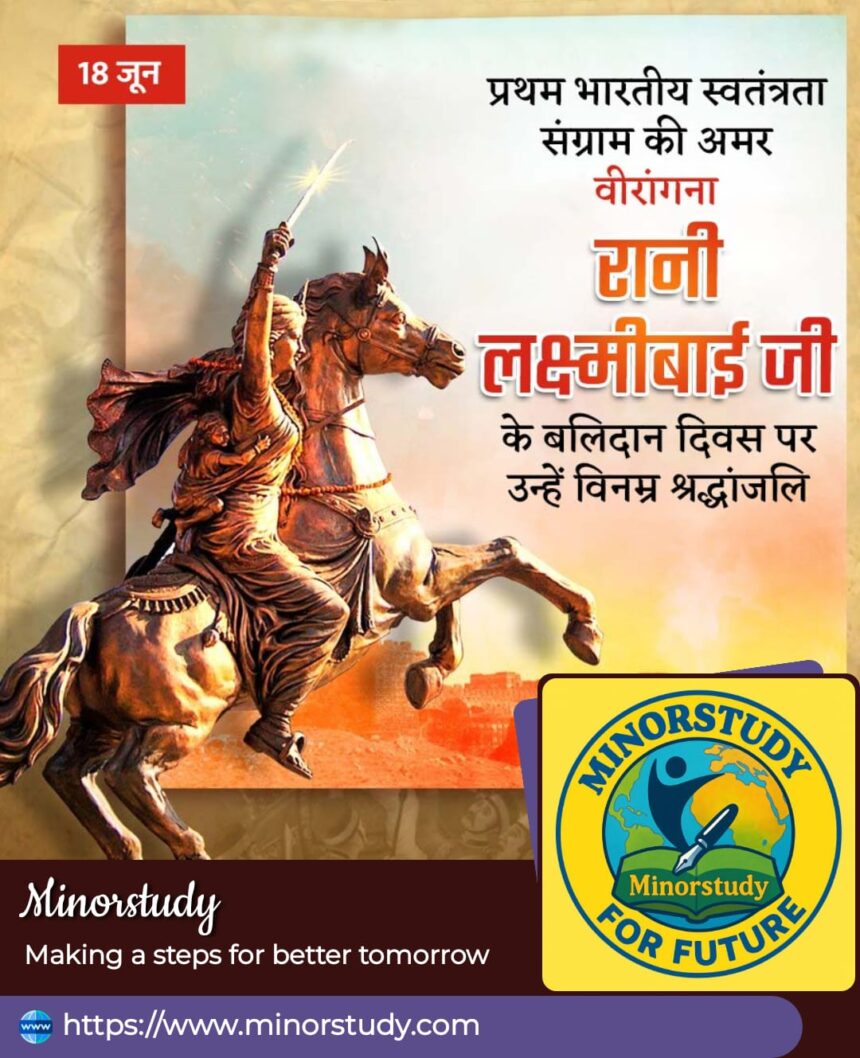10 Fearless Facts About Rani Lakshmi Bai – The Bold Queen Who Dared to Fight the Empire
Introduction: A Flame of Courage in Colonial Darkness
Rani Lakshmi Bai: India’s long journey to independence was lit by many flames of bravery, but none shone brighter or fiercer than that of Rani Lakshmi Bai of Jhansi. Known for her fearless resistance against British rule during the First War of Indian Independence in 1857, her name continues to inspire generations.
- Introduction: A Flame of Courage in Colonial Darkness
- History of Rani Lakshmi Bai – From Manikarnika to Queen of Jhansi
- Timeline of Rani Lakshmi Bai’s Life
- 10 Fearless Facts About Rani Lakshmi Bai
- Significance in Indian History
- FAQs About Rani Lakshmi Bai
- Q1: What was Rani Lakshmi Bai’s real name?
- Q2: Why did Rani Lakshmi Bai rebel against the British?
- Q3: How did she die?
- Q4: What is the significance of the slogan “Main Jhansi nahi doongi”?
- Q5: Are there any monuments or movies about her?
- Wishing the Warrior Queen – A Salute of Respect
- Impact on Our Daily Life and Society
- Why Rani Lakshmi Bai is Important in Our Life
- Observance and National Recognition
- Conclusion: A Flame That Refused to Be Extinguished
- Quick Summary:
She was not just a warrior queen — she was a mother, a patriot, and a symbol of unyielding strength in the face of imperial tyranny. This article uncovers the history, facts, timeline, FAQs, significance, and life-changing lessons from her story.
History of Rani Lakshmi Bai – From Manikarnika to Queen of Jhansi
Born as Manikarnika Tambe on November 19, 1828, in Varanasi, she was raised in a Brahmin family. After the death of her mother at an early age, her father, Moropant Tambe, ensured she was educated in subjects traditionally reserved for men — including horse riding, sword fighting, and archery.
In 1842, she married the Maharaja of Jhansi, Gangadhar Rao, and took the name Lakshmi Bai. After the death of their infant son, they adopted a child named Damodar Rao. But this was rejected by the British under the “Doctrine of Lapse”, which declared that Jhansi would be annexed.
Rani Lakshmi Bai refused to surrender her kingdom and declared:
“Main apni Jhansi nahi doongi” (“I shall not surrender my Jhansi”).
Thus began a legendary resistance.
Timeline of Rani Lakshmi Bai’s Life
| Year | Event |
|---|---|
| 1828 | Born in Varanasi as Manikarnika |
| 1834–35 | Moves to Bithoor with her father after mother’s death |
| 1842 | Marries Maharaja of Jhansi and becomes Rani Lakshmi Bai |
| 1851 | Birth of son, who dies soon after |
| 1853 | Maharaja dies; adopted son Damodar Rao rejected by British |
| 1857 | Leads rebellion during Indian Mutiny |
| 1858 | Dies in battle on June 18, fighting British forces bravely |
10 Fearless Facts About Rani Lakshmi Bai
Started training as a warrior at a young age – mastering sword fighting, shooting, and horse riding.
Refused to submit to the British Doctrine of Lapse, unlike many other rulers.
Led troops into battle dressed as a man, fighting with her child on her back.
Created a women’s army of fierce warriors in Jhansi.
Formed alliances with Tatya Tope and Nana Sahib to strengthen the resistance.
Defended Jhansi Fort against a 3-week British siege with unmatched valor.
Her final battle was hand-to-hand combat, where she was mortally wounded but not captured.
British officers praised her bravery, calling her the “most dangerous of all Indian leaders.”
Her loyal followers cremated her secretly, so her body wouldn’t be desecrated.
Even British historians wrote of her with respect and awe, which was rare.

Significance in Indian History
Rani Lakshmi Bai holds a mythic status in Indian history, not just for her martial skill, but because she:
Symbolized early Indian nationalism.
Was one of the first female leaders to fight colonization head-on.
Inspired future freedom fighters like Bhagat Singh, Subhas Chandra Bose, and Indira Gandhi.
Became the face of the 1857 uprising, which sowed seeds of Indian independence.
She wasn’t just a queen—she was a revolution wrapped in courage.
FAQs About Rani Lakshmi Bai
Q1: What was Rani Lakshmi Bai’s real name?
Ans: Manikarnika Tambe. She took the name Lakshmi Bai after her marriage.
Q2: Why did Rani Lakshmi Bai rebel against the British?
Ans: The British refused to recognize her adopted son as heir, attempting to annex Jhansi under the Doctrine of Lapse. She fought to protect her kingdom and her people’s right to self-rule.
Q3: How did she die?
Ans: She died in battle on June 18, 1858, in Gwalior, fighting against the British in disguise, ensuring she was never captured.
Q4: What is the significance of the slogan “Main Jhansi nahi doongi”?
Ans: It reflected her unyielding patriotism and determination to defend Jhansi, making it a symbol of resistance.
Q5: Are there any monuments or movies about her?
Ans: Yes. Statues of Rani Lakshmi Bai stand in Jhansi, Gwalior, Delhi, and Lucknow. Films like “Manikarnika: The Queen of Jhansi” celebrate her legacy.
Wishing the Warrior Queen – A Salute of Respect
Every 19th November, on her birth anniversary, India celebrates Rani Lakshmi Bai Jayanti. Tributes pour in from schools, women’s organizations, military parades, and cultural events across the country.
People pay homage by reciting her poems, dramatizing her battles, and remembering her not as a tragic figure—but as a triumphant spirit that never gave in.
Let us remember her not just with garlands, but with action — by empowering women, defending justice, and standing up for our rights.
Impact on Our Daily Life and Society
Rani Lakshmi Bai is a timeless icon of feminine strength and patriotic resolve. Her life teaches us:
Stand for what is right, even if the odds are against you.
Courage has no gender.
Leadership is about protecting your people, not just power.
One voice of resistance can inspire millions to rise.
From Indian Army female regiments to school textbooks, from motivational talks to national films — her legacy lives on, empowering every Indian to dare, dream, and defend.
Why Rani Lakshmi Bai is Important in Our Life
Role model for women – breaking stereotypes about what women can achieve.
Patriot icon – a blueprint for national pride and sacrifice.
Historical landmark – her actions influenced early resistance against colonialism.
Symbol of dignity and justice – reminding us to protect our rights with courage.
Modern influence – her legacy continues in politics, art, education, and military ethos.
Observance and National Recognition
Rani Lakshmi Bai Jayanti (19 November) – celebrated nationwide.
Statues and memorials in Gwalior, Jhansi, and Lucknow.
Named in honor: Rani Laxmi Bai Central Agricultural University, Jhansi; Lakshmi Bai College, Delhi; and various public institutions.
Featured in Indian postal stamps, films, songs, and poems.
Conclusion: A Flame That Refused to Be Extinguished
Rani Lakshmi Bai was not born into power — she earned it with valor. Her spirit of fearlessness, her sharp mind, and her will to never surrender made her a living legend.
Her story is not just about a queen who died in battle, but about a woman who chose battle over bondage, courage over compromise, and patriotism over personal safety.
To this day, she whispers in the hearts of the brave:
“If I must die, I will fight first. And I will die last.”
Let us live by her legacy.
Let us all have a little Jhansi Ki Rani inside us.
Quick Summary:
Born as Manikarnika Tambe in 1828.
Fought the British in the 1857 rebellion.
Died on June 18, 1858, in Gwalior, in battle.
Remembered as one of India’s greatest freedom icons.
Her story inspires women’s empowerment, courage, and nationalism.
Celebrated with statues, schools, universities, and annual tributes.
A symbol of resistance not just in history, but in the soul of India.









Hola! I’ve been reading your website for some time now and finally got the courage to go ahead and give you a shout out from Huffman Texas! Just wanted to tell you keep up the excellent job!